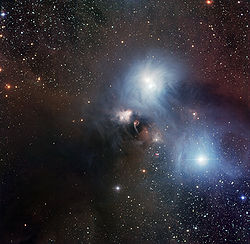| Observation data Epoch J2000.0 Equinox J2000.0 | |
|---|---|
| Constellation | Corona Australis |
| Right ascension | 19h 01m 53.6503s [1] |
| Declination | −36° 57′ 07.87″ [1] |
| Apparent magnitude (V) | +11.91 |
| Characteristics | |
| Spectral type | B5IIIpe [2] |
| Variable type | INSA [3] |
| Astrometry | |
| Radial velocity (Rv) | −36.0±4.9 [4] km/s |
| Proper motion (μ) | RA: 1.582 [5] mas/yr Dec.: −30.835 [5] mas/yr |
| Parallax (π) | 10.5361±0.6971 mas [5] |
| Distance | 152.9+8.1 −7.3 [6] pc |
| Absolute magnitude (MV) | −0.30 [7] |
| Orbit | |
| Period (P) | 45±2 [8] yr |
| Semi-major axis (a) | 0.1968±0.0045 [8] " (27-28 AU [6] ) |
| Eccentricity (e) | 0.4 [6] |
| Inclination (i) | 70 [6] ° |
| Details | |
| A | |
| Mass | 3.5 [7] M☉ |
| Radius | 6.2 [7] R☉ |
| Luminosity | 132 [7] L☉ |
| Temperature | 9,550 [7] K |
| Age | 1+1 −0.5 [6] Myr |
| B | |
| Mass | 0.3 - 0.55 [6] M☉ |
| Surface gravity (log g) | 3.45±0.06 [6] cgs |
| Temperature | 3,650 - 3,870 [6] K |
| Other designations | |
| CD−37°13027, HIP 93449, Wray 15-1887 | |
| Database references | |
| SIMBAD | data |

R Coronae Australis (R CrA) is a variable binary system in the constellation Corona Australis. [2] [8] It has varied between magnitudes 10 and 14.36. [10] A small reflection/emission nebula NGC 6729 extends from the star towards SE. It is also the brightest feature of the Coronet Cluster, therefore sometimes called R CrA Cluster.
This star is moving toward the Solar System with a radial velocity of 36 km s−1. It was previously believed that in roughly 222,000 years, this system could have approached within 1.77 light-years (0.54 parsecs ) of the Sun. However, the estimate had a considerable margin of error in it. [11] With the release of Gaia DR2, the star was determined to be 4 times further from the Sun than initially believed, constraining the approach to only 111 ± 31 light-years (34.0 ± 9.5 parsecs ). [5] Examination of other objects known to be in the same star-forming region gives a distance of 152.9+8.1
−7.3 pc , suggesting an error in the Gaia parallax for R CrA itself. [6]
Johann Friedrich Julius Schmidt discovered that R Coronae Australis is a variable star, in 1865. It appeared with its variable star designation in Annie Jump Cannon's 1907 work Second Catalogue of Variable Stars. [12]
A companion to the star was proposed in 2019 with a mass between 0.1 and 1 Solar masses, depending on the characteristics of the stellar environment, orbiting the primary in 43–47 years. [8] The companion was later directly observed to be a red dwarf with a mass between 0.3 M☉ and 0.55 M☉. [6] It has also been proposed that the primary component is itself a close binary. [7]
